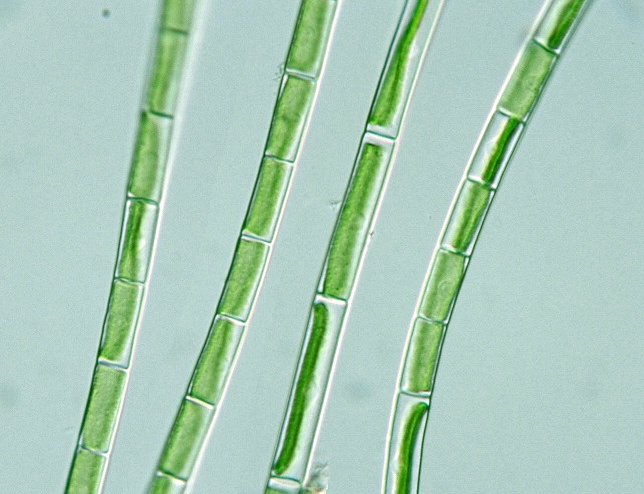Family: Zygnemataceae
Collection Date: November 13th, 2011
Location: Southeast Pond, Hiram College Field Station, Hiram, Ohio
Collector: Katie Rumora
Key Used:
Bellinger, E. G., & Sigee, D. C. (2010). Freshwater Algae: Identification and Use as Bioindicators . Oxford : Wiley-Blackwell.
1b. Plants microscopic or if visible to the naked eye it is normally because they are present as a mass – but still requiring microscopic observation to determine the more detailed morphology … 3
3a. Cells grouped together to form a filament, strand or ribbon. Sometimes filaments can grow in such a profusion to be visible en masse, or are visible as multiseriate rows encrusting stones … 4
4a. Cell pigments localized in chloroplasts. Colour when fresh may be grass green, pale green, golden to brown, olive green or (rarely) blueish or reddish … 5
5b. Filaments or ribbons unbranched … 24
24b. Cell wall not made of silica … 30
30b. Chloroplasts not in the form of a spiral band … 31
31b. Cells not embedded in a prominent mucilaginous envelope ... 32
32b. Filament outline without constrictions and does not have toothed appearance ... 34
34b. Filaments many cells in length, not typically short ... 35
35b. Alga not a large tubular thallus ... 36
36b. Chloroplast either single or more than two per cell ... 37
37a. One chloroplast per cell in the form of a flat plate arranged along the axis of the cell. When viewed from one direction, the chloroplast fills most of teh cell but when viewed from the other it is a thin line down the middle ... Mougeotia
Description:
"The chloroplast of Mougeotia is suspended on cytoplasmic strands and can move within the cell depending upon the light. Hence sometimes it may be seen face-on, sometimes edge-on, and sometimes twisted. The cells form long unbranched free floating filaments. Common in many habitats"

No comments:
Post a Comment